-
Software
-
CAM software
- Tebis Automill
- CNC programming
- CNC automation
- CNC simulator
- Multiple setup
- Robotic machining
- CNC drilling
- Deep-hole drilling
- Combined turn-milling
- CNC turning
- Turn-milling
- 2.5D milling
- 3D milling
- 5-axis milling
- Slot milling
- Trimming
- HPC milling
- HFC milling
- Circle-segment cutters
- Sinker EDM
- Wire EDM
- 3D laser cutting
- Laser hardening
- Laser weld cladding
- CAD software
- CAQ software
- MES software
- Products
-
CAM software
- Services
- Consulting
- Sectors
- References
- Company
- News

-
 Home References
Home ReferencesDemanding thermoformed components for commercial vehicles
Appearances count
Company
Hopf Kunststofftechnik
Location
Besigheim-Ottmarsheim, Germany
Focus
Surface Design, 3+2-Axis NC programming, 5-Axis Trim Machining
Benefits:
- No more teach-in
- Incorporate changes at the click of a button
- Significantly lower processing times
Sector
Mold manufacturing
Automotive
Published
2014

Interviewee: Bernd Hopf, Jürgen Hopf, Commercial managing director, Technical managing director

If we weren't using Tebis, we wouldn't be where we are today.
Jürgen Hopf, Technical managing director, Hopf Kunststofftechnik, Besigheim-Ottmarsheim, GermanyTerex Compact Germany GmbH and Hopf Kunststofftechnik GmbH
The construction machines at Terex Compact Germany GmbH set things in motion. The machines are used in road construction and mining as well as in quarries, horticulture and landscaping. The newest generation meets the highest demands – and not just technically. The icing on the cake: visual subtleties like the appealing design of the interior paneling.
More powerful at lower fuel consumption, temperature-controlled reversible fans, several independent auxiliary control circuits and simplified access to the service component – the 2014 generation of the Terex excavator is state-of-the-art, and clearly stands out from previous models.
Even its exterior appearance is perfect. For example, the TC 125 compact crawler-excavator stands out with the attractive treatment of the interior paneling.
"The days when construction machines had to be simply functional are definitively over," says Bodo Deuster, who checks the quality of the construction machines at Terex Compact Germany GmbH. "Our customers place a lot of emphasis on an appealing exterior. The overall appearance has to be just right."
That’s why details like corners and transitions in the plastic components of the cabin interior had to be refined, even after testing the first TC 125 prototype. For this task, Terex asked for the support of Hopf Kunststofftechnik GmbH in Ottmarsheim in Württemberg, Germany.
A Tebis Support employee digitizes the cover of the operator panel. The sculptured surfaces are reverse engineered with the Tebis Reverser. They correspond to the mesh geometry.
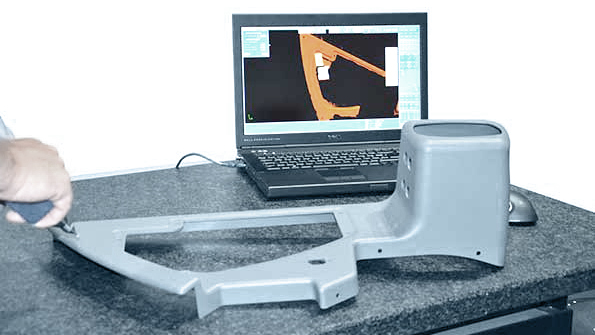
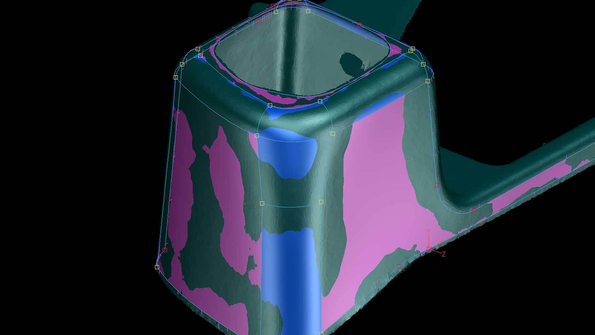
Using the various functions of the surface design module, radii and transition areas are freshly and precisely designed. The result: surfaces without gaps or kinks.
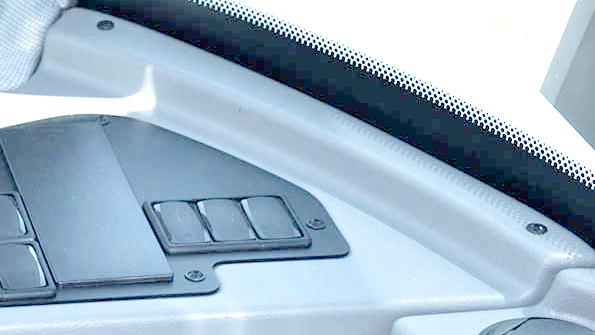
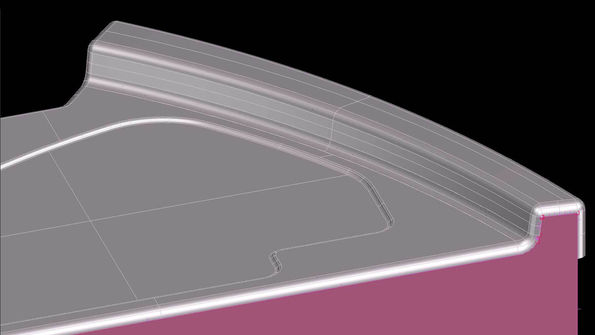
Expert contact in mold manufacturing
Hopf Kunststofftechnik is the right address when you’re looking for an expert contact in the areas of thermoforming and container and instrument manufacturing – as well as outstanding design and manufacturing services.
Manfred Hopf founded the company in 1969. Today the senior partner shares the company’s management with his sons Bernd and Jürgen. All deep-draw dies are manufactured in-house.
This was not always the case. "After we purchased the first deep-draw machine in 1985, we were able to manufacture simple tools that could be derived from 2D drawings. But complex tools based on 3D shapes had to be purchased," says Bernd Hopf, who – as the commercial director of the family company – keeps an eye on the finances.
"And the maintenance, personnel and material costs were definitively too high for trimming operations.
All of the tasks involved could only be realized after time-consuming teach-in procedures. The machine operator had to manually position and orient the tools."
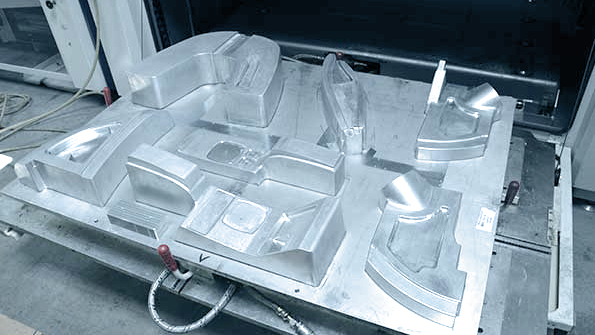 Left image: Hopf Kunststofftechnik imports the data set supplied by Tebis Support, derives the deep-draw die and the fixture for the trimming process and creates the NC programs based on manufacturing templates in the Job Manager.
Left image: Hopf Kunststofftechnik imports the data set supplied by Tebis Support, derives the deep-draw die and the fixture for the trimming process and creates the NC programs based on manufacturing templates in the Job Manager.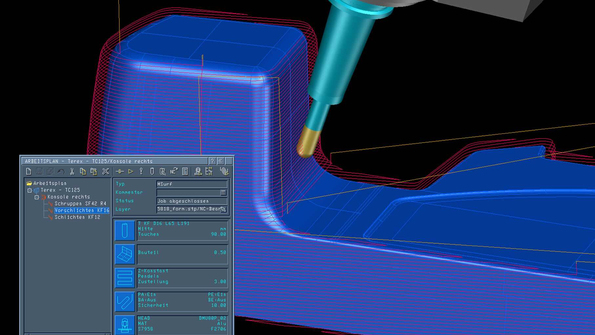 Right image: Model plate with typical deep-draw shapes.
Right image: Model plate with typical deep-draw shapes.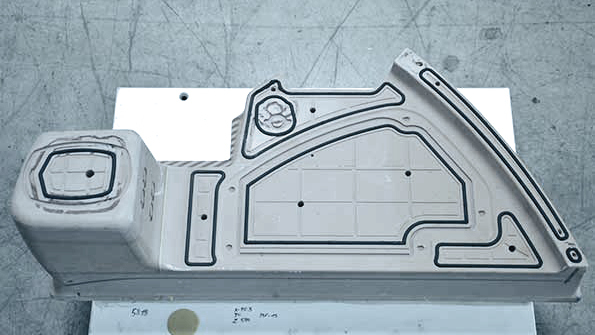 Left image: The trimming fixture is ready.
Left image: The trimming fixture is ready.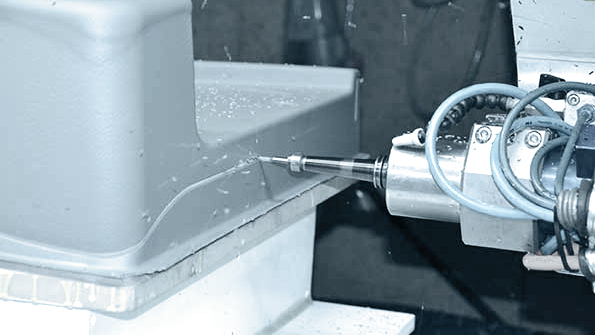 Right image: The side panel is trimmed.
Right image: The side panel is trimmed.Moving away from teach-in, thanks to new software
Luckily, everyone knows everyone else in the world of tool and mold manufacturers, and they all share their problems and experience. "Try the CAD/CAM software from Tebis" – this piece of advice is frequently heard. "And that's just what we’ve been doing." That was 14 years ago. "We never regretted this decision," says Jürgen Hopf, the technical director of the company.
"Anyone can do deep-drawing. But you definitely need a system like Tebis to efficiently manufacture dies. Our work processes can no longer be compared with earlier ones.
We used to need an entire week to manufacture and trim a die. With Tebis, we’ve been able to reduce the entire process to a single day.
That means that we can manufacture all of our dies in-house and don't have to contract with third parties.
As a result, we’ve invested heavily in machines." Today the company has a staff of 53 employees and owns an impressive array of machinery, including eight deep-drawing machines and twelve milling machines.
They now have three Tebis workstations where all components are programmed. Among other tasks, Hopf uses the modules for surface design, 3+2-axis NC programming and 5-axis trimming.
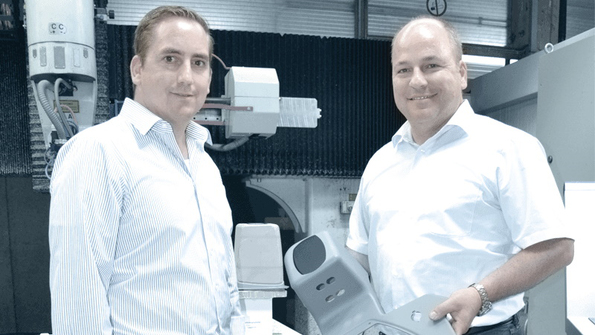 Jürgen and Bernd Hopf with the new side panel in front of the trimming machine.
Jürgen and Bernd Hopf with the new side panel in front of the trimming machine."The various machining operations can be combined beautifully. And the template technology in Tebis is just great. Modifications to holes and contours are made at the click of a button and are immediately available to all users, making it easier to plan machine utilization.
Surface quality is outstanding, and the programs run with no errors. Our manufacturing times are now significantly shorter. Tebis is absolutely the right program for us for free-form surfaces," says Jürgen Hopf, himself a passionate programmer who works with the system every day. His conclusion: "If we weren't using Tebis, we wouldn't be where we are today."
Service, programming and manufacturing – one software, multiple players
Tebis defines itself equally as system supplier and service provider, and it responds flexibly to specific customer requirements.
At Hopf Kunststofftechnik, they appreciate the excellent, expert and friendly customer support. Bernd Hopf's comment: "When Terex approached us, we knew that we could totally rely on Tebis.
Working together and in a very short time, we found the best possible solution to quickly reach our goal and to deliver high-quality work."
The production of the interior cabin of the TC 125 is indeed a textbook example of the seamless integration of external services in company-internal processes
Jürgen Hopf explains in more detail: "Because we didn't have a CAD data set, we had to digitize the prototype's plastic components and reverse engineer the surfaces.
The transitions had to be redesigned according to the specifications from Terex. We even extended the side panels to obtain a uniform color appearance.
Because reverse engineering is not part of our portfolio, we handed over all the CAD work to Tebis. On the other hand, we created the NC programs, and so we were able to offer the entire process to Terex.
The entire project was completed within four weeks."
With 22,000 employees worldwide, Terex Corporation is a diversified, globally active manufacturer in machine and plant engineering. Terex Corporation’s core business is providing reliable, customer-oriented solutions for numerous applications including construction and infrastructure, shipping and transportation, mining, refining, energy, municipal services and manufacturing operations. Terex comprises five business segments: Aerial Work Platforms, Construction, Cranes, Material Handling & Port Solutions, and Materials Processing. Terex Compact Germany GmbH is headquartered in Crailsheim, Germany.


